Kimchi stew is one of the most-loved of all the stews in Korean cuisine. It’s a warm, hearty, spicy, savory, delicious dish that pretty much everyone loves. As long as they can handle spicy food, I never met a person who didn’t like kimchi-jjigae.
I learned this recipe from a restaurant famous for kimchi-jjigae in Korea. The restaurant was always full of people eating and sweating over kimchi stew. There was only one item on the menu, so everyone was there for the same thing: a steaming pot of spicy kimchi-jjigae, a few side dishes, and a bowl of warm rice. Customers would call out: “Please give me another bowl of rice!”
What really made an impression on me at the time was the fact that they brought the stew out to the table uncooked, and then fired up a burner and cooked it at the table. This way we could sit and talk and watch it cook. I could get a good look at the ingredients: kimchi, onion, green onion, thinly sliced pork on top, and seasonings. There was some white granules (salt, sugar, and probably MSG) and also they used water at the broth base.
From this I developed my own recipe to make at home, which was very delicious.
My kimchi-jjigae recipe served me well for years and years and I even made a video of it in 2007. But since then I developed this version, which is even more delicious. The secret is in the savory anchovy stock.
I hope you make it and enjoy it for years and years to come!
The difference between kimchi soup and kimchi stew
Kimchi stew is thicker than kimchi soup. Kimchi soup is less salty than kimchi stew.
Also, soup is always served in individual bowls, with rice. Traditionally in Korean cuisine stews were served in a big pot on the table, and the family would eat communally from the pot. These days, some people (including me) get a little freaked out by double-dipping, so for stews I put individual bowls on the table, and a large spoon so that diners can take what they like from the pot and put it in their bowls.
Ingredients
(serves 2 with side dishes, serves 4 without)
- 1 pound kimchi, cut into bite size pieces
- ¼ cup kimchi brine
- ½ pound pork shoulder (or pork belly)
- ½ package of tofu (optional), sliced into ½ inch thick bite size pieces
- 3 green onions
- 1 medium onion, sliced (1 cup)
- 1 teaspoon kosher salt
- 2 teaspoons sugar
- 2 teaspoons gochugaru (Korean hot pepper flakes)
- 1 tablespoon gochujang (hot pepper paste)
- 1 teaspoon toasted sesame oil
- 2 cups of anchovy stock (or chicken or beef broth)
For stock (makes about 2½ cups’ worth):
- 7 large dried anchovies, heads and guts removed
- ⅓ cup Korean radish (or daikon radish), sliced thinly
- 4×5 inch dried kelp
- 3 green onion roots
- 4 cups water
Directions
Make anchovy stock:
- Put the anchovies, daikon, green onion roots, and dried kelp in a sauce pan.

- Add the water and boil for 20 minutes over medium high heat.
- Lower the heat to low for another 5 minutes.
- Strain.

Make kimchi stew:
- Place the kimchi and kimchi brine in a shallow pot. Add pork and onion

- Slice 2 green onions diagonally and add them to the pot.
- Add salt, sugar, hot pepper flakes, and hot pepper paste. Drizzle sesame oil over top and add the anchovy stock


- Cover and cook for 10 minutes over medium high heat.

- Open and mix in the seasonings with a spoon. Lay the tofu over top.


- Cover and cook another 10 to 15 minutes over medium heat.
- Chop 1 green onion and put it on the top of the stew. Remove from the heat and serve right away with rice.

Maangchi's Amazon picks for this recipe
It's always best to buy Korean items at your local Korean grocery store, but I know that's not always possible so I chose these products on Amazon that are good quality. See more about how these items were chosen.






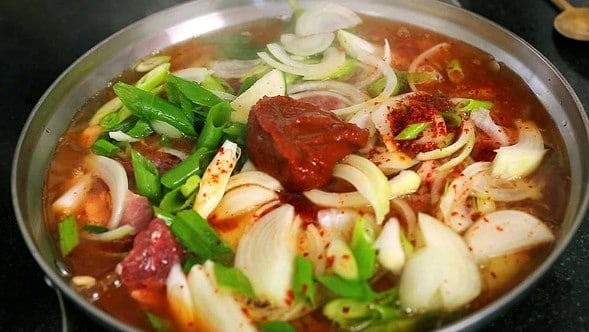



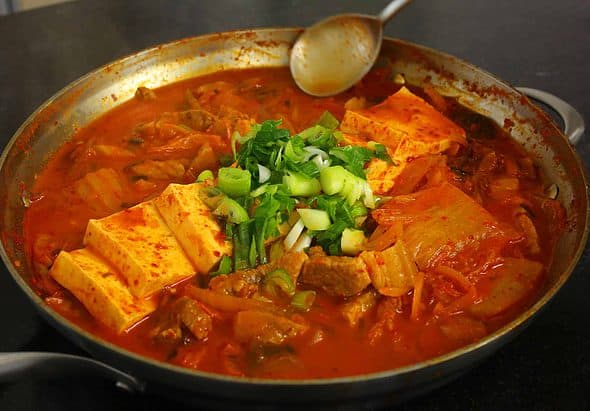











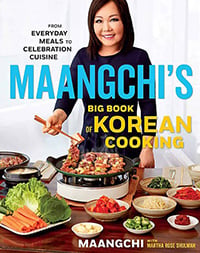































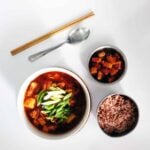


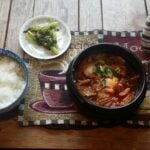

I have a severe shellfish allergy. I’ve made kimchi before without shrimp but would like to try yours. Is there something I can use as a substitute or omit it completely?
Add more fish sauce then.
First attempt – used fish stock and an extra tablespoon of gochujang. I love how quick and easy this was to make.
See full size image
It looks great You added more gochujang! : )
THANK YOU SO MUCH MAANGCHI! I love Korean food, but the closest korean restaurant is two hours away :-( But with your recipes I can bring Korea home. My husband and two year old daughter loves it!
I did the Kimchi Jjigae last night and it was so good I had seconds! Only thing is next time I will try with older kimchi, for a stronger taste. And with fried tofu, yum. I’m getting hungry just thinking about it.
Merry Christmas!
See full size image
Thank you for sharing your kimchi jjigae photo! The arrangement in the pan looks like mine! Cute~ : ) I’m glad your family loved it. Your 2 year old baby will always love kimchi stew just like a Korean baby. lol
Maangchi! I’m in love with your recipes:) I made your kkakdugi and my family loved it! I’m a 15 year old Chinese girl(living in the u.s.) who loves Korean food.
I was wondering, since I don’t have gochujang, would it taste okay without it or would I need it? Thank you!
Maangchi~ Thank you so much for the updated version of your recipe!
I made it last week and my house smelled soooo good!
Instead of the pork belly or shoulder, I used some leftover tenderloin and cut it against the grain, it tasted like beef!
See full size image
Try pulled pork roast or well cooked pork neck bone meat also. Add it to a bowl just before serving so it does not completely fall apart during cooking the stew. The stock from neck bones is also wonderful in kimchi jjigae.
I use pork loin a lot for stews but its a little light on fat. The neck bone stock helps add back a little of the fat but not too much..
How many servings/ppl will be eating based on yr kimchi stew recipe?
If you only eat kimchi-jjigae then it will serve 2. But if you have other side dishes it will serve 4.
I’m going to cook this weekend , for sure my family will enjoy this yummy Kimchi!
Hi Maangchi, i love this! However, wondering what’s the difference between this kimchi stew and kimchi soup?
Maangchi, this was delicious! I made it with two cans of tuna. I’ve been following your recipes for about 3 years now I think but I have never posted a reply. Thanks to you, I can cook delicious Korean food. I will be purchasing your new book, too! Thank you for everything!
Kimchi stew with canned tuna sounds great! Actually it’s one of my cookbook recipes. Cheers!
Thanx for the recipe.. I LOVE IT
See full size image
Delicious!
I have a tip for those of you who want to preserve the leftovers.
Cool them in the refrigerator and just put them in plastic bags and throw into a freezer. You can keep it almost indefinitely. When you want to cook it just throw into a pot with boiling water and it will taste as good as new.
I used to this during my college days. I would go home from time to time to get frozen kimchijjgae and keep them in my freezer.
I did this in college too! We didn’t have a kitchen my first year, so I used a little electric tea kettle. It works for any kind of soup or stew. Lots of memories!
I have some laver can I add that in there ?
Also I’ve seen ramyun being added can that be added ? Or is that just ones personal preference ?
Thank you Maangchi for the recipe, I tried it and it was really delicious. I would like to know if I can add both tuna and pork – will it make it even better?
Yes, you can add tuna and pork, why not?
Made this with some leftover corned beef instead of pork belly as a quick meal, it was so good it made me want to cure another brisket just to make stew with!
I added enoki enoki mushroom and king oyster mushroom. They added extra flavor to the stew. Taste so good!!! Thank you for the recipe!
Dear Maangchi,
Thanks for your recipes. I’ve made kimchi napa cabbage 3 days ago. I want to try kimchi stew for lunch, can i use chicken breast? Thankyou.
Yes, you can use chicken breast, too.
Hi Maangchi, how much is 4-5 cups in gram? Haha because we use gram/kilo here ^^ Thank you.
Hi Maangchi,
Is it possible to tweak the kimchi jigae recipe a little to make Korean army stew instead? I love Korean army stew and can’t stop eating this whenever I visit Korean restaurant. I love the part where instant noodles are cooked in the stew.
Hello Maangchi :)
It is possible to use kimchi bought from supermarket right? But everytime i see the packing, it does not have enough kimchi juice, so what do i do?
of course you can use store bought kimchi! You may have to use more kimchi if it doesn’t contain much juice. Good luck with making super tasty kimchi jjigae!
Alright! Thank you for the guide :)
I’ve found if you add 1 cup of water with a tsb of gochugang it makes up for the missing kimchi juice
I made this with my daughter today!!!! The only thing we did differently was to fry the tofu beforehand so that it would be chewy. It was absolutely delicious!!!! We watch you everyday and have probably seen all of your videos 50 times over on YouTube!!!! Thanks so much, Maangchi!!!!
“fry the tofu beforehand so that it would be chewy.” yes, it sounds great!
I like tofu fried also for soups and stews. I use a chili oil for the frying and just lightly brown the tofu.
Ive found that boneless country style ribs work extremely well for Jjigae and they are often cheap. They have a nice balance of fat too meat. Slicing them while partially frozen is much easier than completely thawed.
I also stir fry my pork with some of the onion (not all) and pepper paste first.. Then add the kimchi and fry for another couple of minutes before adding the broth.This brings out a little more sweetness from the onion and changes the flavor of the pepper paste slightly..
Hi Maangchi, I’m curious if there is any particular reason we should use a shallow pot for kimchi-jjigae? Is this just tradition, or does it affect the end product?
oh, good thinking! Actually there is no particular reason to use a shallow pot. You can use a deep and narrow pot, too. But I think the stew cooked and served in a shallow pot will look better on the table and easier to share.
thats CHAYOTE!!! We have a lot of that here in the Philippines – we eat them stir fried with rice – mmm so good. We pronounce it as “sa-YO-teh”
Hi Maangchi! I made this kimchijjigae after work one night and it was so easy and delicious! My wife who is an awesome cook usually handles the dinner, so I am spoiled and not a good cook ^^. I think using your excellent hommade kimchi recipe as the base is what makes it so good! Between this and the kimchijeon, I will have to start making kimchi at least once a month!
감사합니다!
Dave
Hello Maangchi,
can i store unfinished portions in the fridge? if so how long can i keep it for?
also, can i use sliced pork belly? will that reduce the cooking time?
You can keep the leftover kimchi stew in the fridge up to 1 week.
Hi!
I was wondering how many people does this recipe feed?
I am having a dinner with 7 people and want to make this so i am wondering if i can use this one or if i should double the amount?
It will serve 2 -4 people. Yes, you can double the recipe if you make it for 7 people.
Hi Maangchi!
I dont have tofu right now, how can I replace it or should I skip iit?
Thanks!!!
yes, skip it. It will still be delicious.
Maangchi, thank you so much for posting these recipes. My mother left when I was nine so I was unable to eat homemade Korean food for a long time. Now I can make it myself! I had a question though, what is the difference between kimchi jjigae and kimchi guk?
They are different. Kimchi soup contains more water. So you can put some rice into the soup and eat it. It’s very delicious in the winter time. Kimchi stew doesn’t contain as much water as kimchi soup and a little saltier. You can eat it with a spoon.
Thank you for recipies Im from Argentina, my wife from south korea ( busan)
And we are expecting her first baby girl Haneul
Her mom was here back in february and she left cause has to work
So you Teach me how to make all kind of korean food thank you a lot
if was not for you she can no get seeweed soup so i make it couple times till i got it rigth and know we are ready
Thank you so so very much!!!!!!!!!!!!!!!!!!!!!!!!!!!!
I can picture the scenes of your cooking miyeokguk (seaweed soup) and side dishes for your wife. Yes, I think you and your wife are ready for the baby! The baby has already the beautiful name “haneul” (sky in Korean) and your wife will be eating delicious miyeokguk that you make. What more would they need! Thank you for sharing your touching story with me and my other readers.
Miyeokguk: https://www.maangchi.com/recipe/miyuk-guk
thank you for wonderful videos! you make everything so easy. its watching a normal person, cook, chop and talk in a normal way, in a normal kitchen! its truly “normal” communication!:-)!!!
Wow, you are an amazing! I will certainly be making this in the near future! Thank you for the fantastic recipes and detailed videos!
What’s up, Maangchi? I wish your videos were around the first time I was trying to make Kimchi Jjigae. The first time I ever made this dish was over ten years ago (when I was in college). I did not even know how to make bap (rice) back then. I would call my mom and ask her how to make such and such. And I remember that Kimchi Jjjigae was one of the first Korean dishes I learned how to make. My first attempt was horrible. It turned out so bland and the Kimchi just looked like it was thrown into hot water, all watered down with no flavor.
Years later, through trial-and-error, my Kimchi Jjigae has come a long way. I actually like it now lol. What I like about your Kimchi Jjjigae recipe is that it is so simple and does not take too much time, great for when you are on the go and don’t have too much time to spend on cooking. The method I use is a little different than yours though. I like to sauté the pork belly first. I love how the caramelized pork belly slices tastes, and I always find myself munching as I cook. I love samgyupsal and even when I am eating samgyupsal by itself to eat, I prefer it to be caramelized and bbassak (not sure the English translation lol). And they taste even better when onion slices are added and sautéed together. I think this adds a deep, rich flavor to the Kimchi Jjigae while it is being simmered. The caramelization from the onions gives a slightly sweet taste to the pork belly slices. I then add the rest of the ingredients (Kimchi, minced Jalapeno, and minced garlic) and seasonings (salt/pepper, soy sauce, red pepper flakes, Dashida, and sugar). And I let it cook a bit before adding the water. At this point, it is good enough to eat it as Kimchi Bokkeum (Kimchi Stir-fried). When I add the water, I also like to add a shitload of Kimchi juice (just my preference), as I find it more flavorful. I finish it off with tofu, spam, and scallions.
Your videos always make me so “behgopa”. Everything you cook and eat always looks so yummy. What do you think of my Kimchi Jjigae? Sorry I need more practice with the camera though!
http://behgopa.blogspot.com/2013/03/kimchi-jjigae-kimchi-stew.html
Hi Maangchi , I’m also really interested in Korean food,but were could I buy chilly paste and black bean paste on the internet?. I live in Puerto Rico (caribean) and there are no Korean markets here that i know of. thanks :)
Hi Maangchi,
Last night after work, I hurriedly went home to try out cooking kimchi jiggae using your recipe. I was in the bus thinking of this mouth-watering stew while my stomach was growling and couldn’t wait to have its fill of kimchi jiggae! Haha!
Much to my taste buds’ delight, my cooking went well and my kimchi stew tasted so much authentic like the ones i’m eating in a Korean restaurant!
Thank you so very much for your awesome recipe!
Thank you for sharing the sweet story! Cheers!
Is there anything to replace kimchi juice ? I buy small packets of kimchi but it hardly contain any juice .
Hello again, just to say that the kimchi stew was really nice !! thank you for sharing <3
Maangchi! Will the dish be just as tasty without the paste and flakes??
I don’t think so. It will turn out too bland.